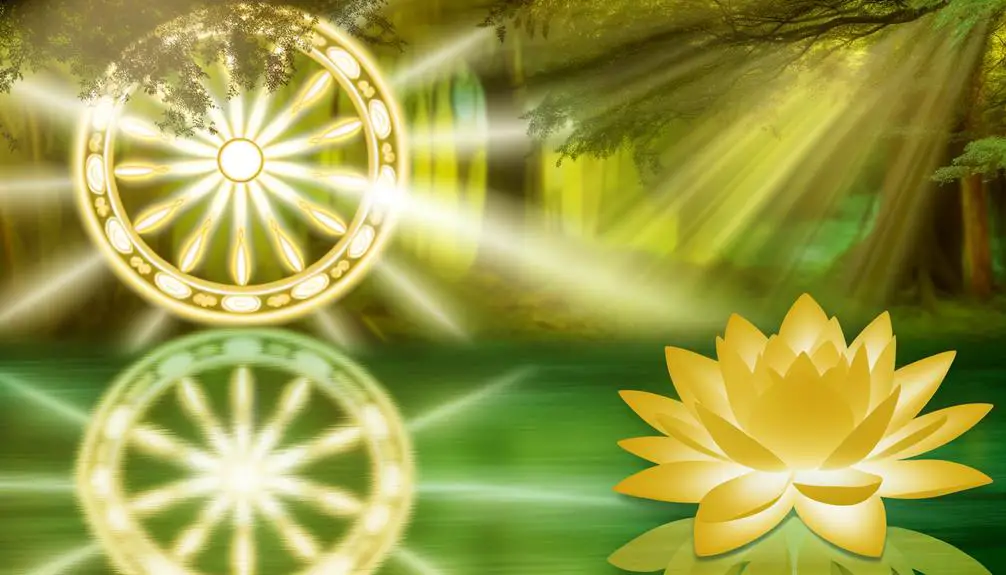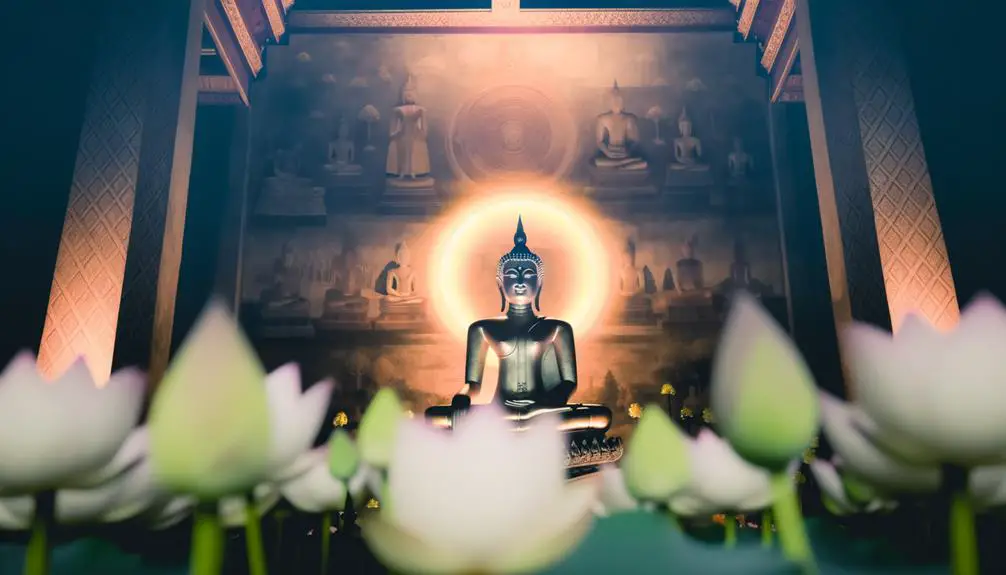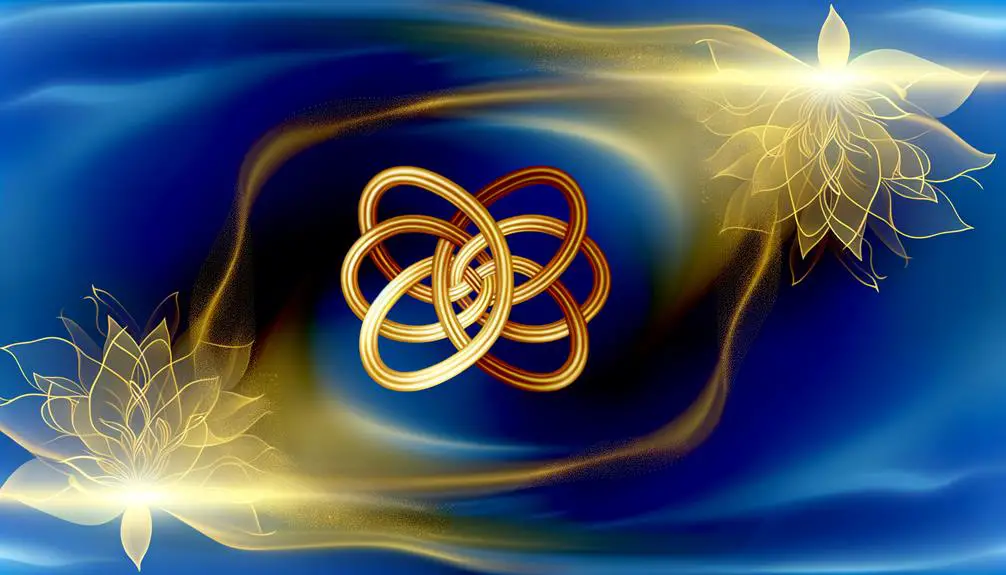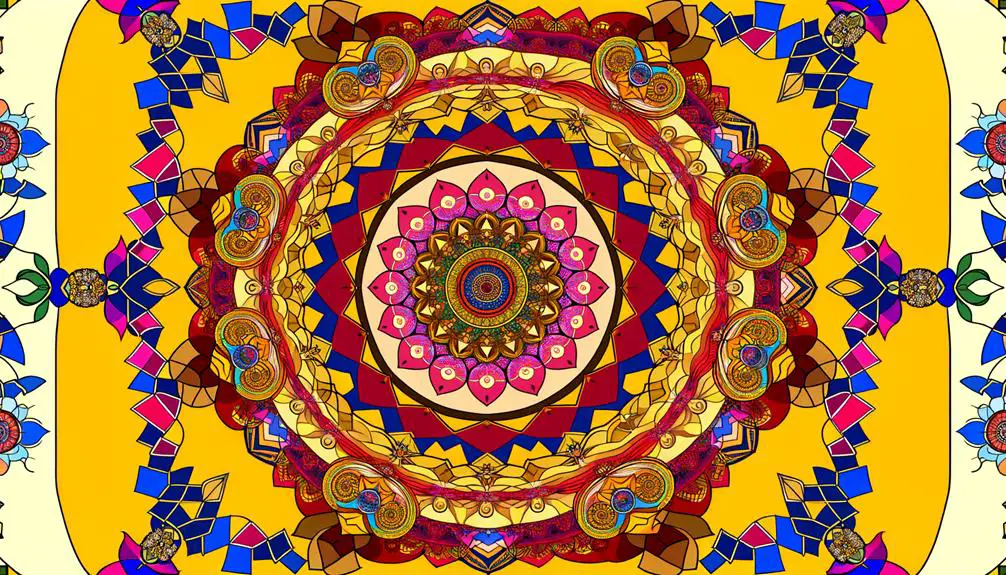Interpreting the Dharma Wheel: Symbol of Buddhism and Its Meaning
Buddhism employs several symbols to convey its spiritual teachings and philosophical principles. The Dharma Wheel represents the Buddha's teachings and the path to enlightenment, reflecting the Noble Eightfold Path.
The Lotus Flower symbolizes purity, spiritual awakening, and enlightenment, illustrating the journey from ignorance to wisdom. The Bodhi Tree marks the site of Siddhartha Gautama's enlightenment and embodies spiritual awakening.
Other symbols like the Endless Knot, Stupa, and Mandala emphasize interconnectedness, the cyclical nature of existence, and the path to inner peace. Exploring these symbols provides deeper insights into the essence of Buddhist doctrine and practice.

Key Takeaways
- The Dharma Wheel symbolizes the Buddha's teachings and the path to enlightenment.
- The Lotus Flower represents purity, spiritual awakening, and the journey from ignorance to wisdom.
- The Buddha Image conveys the spiritual and philosophical tenets of Buddha's teachings.
- The Bodhi Tree signifies spiritual awakening and the pursuit of knowledge, marking the site of Buddha's enlightenment.
- The Endless Knot reflects the interconnectedness of all phenomena and the cyclical nature of existence.
The Dharma Wheel

The Dharma Wheel, or Dharmachakra, is one of the most significant and universally recognized symbols in Buddhism, representing the teachings of the Buddha and the path to enlightenment.
This emblematic wheel encapsulates profound philosophical concepts, primarily revolving around the Noble Eightfold Path, which serves as a guide for ethical and mental development. Each spoke of the Dharmachakra signifies one of the eight elements: right view, intention, speech, action, livelihood, effort, mindfulness, and concentration.
The circular shape of the wheel denotes the perfection of Buddha's teachings and the endless cycle of life, death, and rebirth (samsara).
Historically, the Dharma Wheel's adoption in various cultural contexts highlights its adaptability and the unifying essence of Buddhist doctrine across diverse traditions.
The Lotus Flower

The Lotus Flower is a profound symbol in Buddhism, representing purity, spiritual awakening, and the journey towards enlightenment.
Its stages of bloom, from bud to full flower, metaphorically illustrate the progression of the soul from ignorance to ultimate wisdom.
This symbolism is deeply embedded in Buddhist teachings and practices, highlighting the flower's spiritual significance across various contexts.
Symbolism of Purity
Often emerging from the murkiest waters, the lotus flower embodies the concept of purity and spiritual enlightenment within Buddhist symbolism. Its ability to rise untainted from muddy environments illustrates the potential for individuals to attain purity despite life's challenges and imperfections. This symbolism is deeply embedded in Buddhist teachings, underscoring the path to spiritual awakening and liberation.
The lotus flower's significance can be understood through several key aspects:
- Purity: Represents the mind's transcendence over material and emotional pollutants.
- Spiritual Growth: Illustrates the journey from ignorance to enlightenment.
- Detachment: Symbolizes the ability to remain unstained by worldly desires.
- Resilience: Demonstrates strength and perseverance in overcoming obstacles.
This emblematic representation fosters a profound understanding of personal and spiritual development.
Stages of Bloom
Understanding the stages of the lotus flower's bloom provides insight into the Buddhist perspective on spiritual development and enlightenment.
Initially, the lotus begins its journey from the muddy waters, symbolizing ignorance and suffering. As it ascends towards the surface, it embodies the individual's quest for knowledge and self-awareness.
Upon reaching the water's surface, the partially opened flower represents the initial stages of enlightenment, where wisdom begins to unfold.
Finally, the fully bloomed lotus signifies complete enlightenment and the attainment of Nirvana.
This progression from murky depths to radiant bloom mirrors the transformative path that followers of Buddhism undertake, illustrating a journey from the confines of worldly suffering to the liberation of spiritual awakening.
Spiritual Significance
Revered as a potent emblem of purity and transcendence, the lotus flower encapsulates the profound spiritual principles central to Buddhist teachings. Its growth from murky waters to a pristine bloom symbolizes the path to enlightenment, illustrating the journey from ignorance to spiritual awakening.
The lotus's ability to remain unstained by its environment is a metaphor for detachment and purity amidst life's challenges. Its various colors—white, pink, red, blue, and purple—each convey distinct spiritual meanings, from purity to mysticism.
- Purity: The lotus remains clean despite growing in muddy waters.
- Detachment: Represents rising above worldly attachments.
- Enlightenment: Symbolizes the progression towards spiritual awakening.
- Transformation: Highlights personal growth and spiritual development.
This flower's spiritual significance is therefore multi-dimensional and deeply rooted in Buddhist doctrine.
The Buddha Image

As a central icon in Buddhist practice, the Buddha image encapsulates profound spiritual and philosophical tenets that have evolved over centuries. These representations are not merely artistic but are imbued with symbolic meanings reflecting the Buddha's teachings.
Common features, such as the ushnisha (protuberance on the head) and elongated earlobes, signify wisdom and renunciation of material wealth. The mudras, or hand gestures, convey specific aspects of the Buddha's life and teachings, such as the dharmachakra mudra symbolizing the turning of the wheel of Dharma.
The serene facial expressions and meditative postures aim to inspire inner peace and mindfulness among practitioners. Therefore, the Buddha image serves as a focal point for meditation and spiritual reflection within the Buddhist tradition.
The Bodhi Tree

The Bodhi Tree holds profound historical significance as the site where Siddhartha Gautama attained enlightenment, evolving into the Buddha.
This tree has since become a powerful symbol within Buddhism, representing spiritual awakening and the pursuit of knowledge.
Today, it continues to hold relevance, serving as an enduring emblem of mindfulness and enlightenment in modern Buddhist practices.
Historical Significance Overview
Often regarded as a pivotal symbol in Buddhism, the Bodhi Tree holds profound historical significance due to its association with the enlightenment of Siddhartha Gautama, who became the Buddha. This sacred fig tree, located in Bodh Gaya, India, serves as a cornerstone in Buddhist heritage. Its historical relevance is underscored by various aspects:
- Historical Site: The Bodhi Tree stands at the Mahabodhi Temple complex, a UNESCO World Heritage site.
- Pilgrimage Destination: Attracts millions of pilgrims annually who seek spiritual and historical connection.
- Symbol of Enlightenment: Marks the exact location where the Buddha attained enlightenment.
- Cultural Impact: Influences art, literature, and cultural practices across Buddhist communities.
Understanding these points elucidates the historical importance of the Bodhi Tree within the broader context of Buddhism.
Spiritual Symbolism Explained
Beyond its historical significance, the Bodhi Tree embodies deep spiritual symbolism that permeates various aspects of Buddhist philosophy and practice. Representing enlightenment, the Bodhi Tree stands as a beacon of wisdom, where Siddhartha Gautama attained profound insight. The tree also symbolizes resilience and growth, reflecting the path toward spiritual awakening. The following table encapsulates the emotional and symbolic dimensions associated with the Bodhi Tree:
| Aspect | Symbolism | Emotional Resonance |
|---|---|---|
| Enlightenment | Wisdom | Awe |
| Resilience | Strength | Inspiration |
| Growth | Spiritual Journey | Hope |
| Shelter | Compassion | Comfort |
| Roots | Stability | Security |
These elements collectively underscore the Bodhi Tree's pivotal role in embodying core Buddhist values, facilitating a deeper understanding of its spiritual essence.
Modern-Day Relevance
In contemporary times, the Bodhi Tree continues to serve as a profound symbol of spiritual and cultural significance, resonating with modern practitioners and scholars alike. Its relevance extends beyond historical roots, embodying principles that are increasingly pertinent in today's global context.
The Bodhi Tree symbolizes:
- Mindfulness and Meditation: Encouraging practices that promote mental well-being.
- Environmental Awareness: Highlighting the interconnectedness of life and the importance of ecological stewardship.
- Cultural Heritage: Preserving and honoring ancient traditions within modern society.
- Global Fellowship: Fostering a sense of community and shared values among diverse populations.
These aspects illustrate the enduring relevance of the Bodhi Tree, providing a bridge between ancient wisdom and contemporary challenges, enriching the spiritual and cultural fabric of today's world in this manner.
The Endless Knot

The Endless Knot, a prominent symbol in Buddhism, intricately represents the interweaving of the spiritual path, the flow of time, and the eternal nature of the universe. This geometric figure, characterized by its closed, looping pattern, signifies the interconnectedness of all phenomena.
Its design, devoid of a clear beginning or end, underscores the cyclical nature of existence and the principle of karma, where actions and their consequences are perpetually linked.
In a broader context, the Endless Knot emphasizes the unity of wisdom and compassion, two fundamental aspects of the Buddhist ethos. This symbol serves as a reminder of the mutual dependence of spiritual and worldly spheres, advocating a balanced approach to life grounded in mindfulness and ethical conduct.
The Stupa

As an architectural representation of the enlightened mind, the stupa stands as a significant monument in Buddhism, embodying the essence of the Buddha's teachings and serving as a focal point for meditation and veneration. The stupa's structure is rich in symbolic meaning, with each component reflecting different aspects of Buddhist philosophy.
Base: Represents the earth and the foundation of practice.
Dome: Symbolizes the universe and the mind's expansive potential.
Spire: Reflects the path to enlightenment and the stages of spiritual ascent.
Crown: Often adorned with a jewel, signifying the Buddha's wisdom.
These elements together form a holistic representation of the path to enlightenment, making the stupa an essential element in Buddhist practice and devotion.
The Mandala

Frequently revered for its intricate patterns and profound symbolism, the mandala serves as a powerful tool in Buddhist practice, representing the universe's interconnectedness and the journey towards spiritual enlightenment.
This geometric configuration, often circular in design, encapsulates a microcosm of the cosmos, embodying the cyclical nature of life and the path to a harmonious state of being.
Mandalas are meticulously crafted in various forms, ranging from painted thangkas to ephemeral sand designs, each serving as a meditative aid.
The creation process, seen as a form of meditation itself, reflects impermanence—central to Buddhist philosophy. By engaging with mandalas, practitioners cultivate mindfulness and insight, progressing towards inner peace and ultimate liberation.
The Vajra

How does the vajra, a symbol of both indestructibility and transformative power, encapsulate the essence of Buddhist teachings?
The vajra, often depicted as a thunderbolt or diamond, represents the unyielding nature of truth and the transformative power of wisdom in dispelling ignorance. In Vajrayana Buddhism, it is a ritual implement that signifies the ultimate reality—the indestructible and immutable nature of enlightened consciousness.
- Indestructibility: Symbolizes the unchanging and eternal truth of the Dharma.
- Transformative Power: Represents the ability of wisdom to transform ignorance into enlightenment.
- Dual Nature: Combines opposites such as strength and compassion, reflecting the holistic nature of Buddhist practice.
- Ritual Use: Employed in ceremonies to invoke divine energies and protect against negative forces.
This analysis underscores the vajra's profound significance in Buddhist symbolism.
Conclusion
The symbols of Buddhism—ranging from the Dharma Wheel to the Vajra—embody the profound depths of its philosophy and teachings. Each symbol, steeped in centuries of tradition, represents fundamental aspects of the Buddhist path to enlightenment.
The sheer diversity and richness of these symbols are nothing short of a treasure trove of spiritual wisdom. Understanding these symbols provides invaluable insights into the intricate tapestry of Buddhist thought, offering a monumental contribution to both religious studies and spiritual practice.






